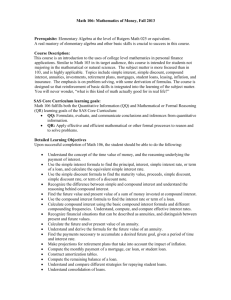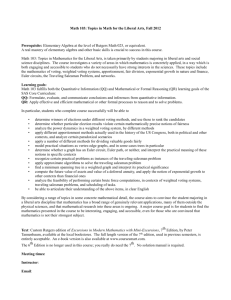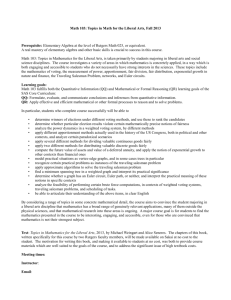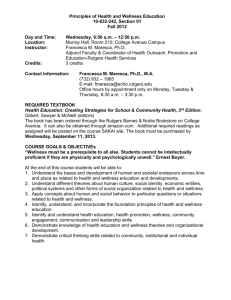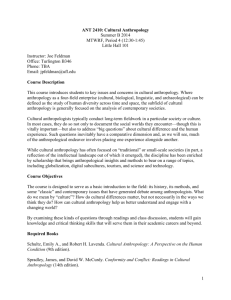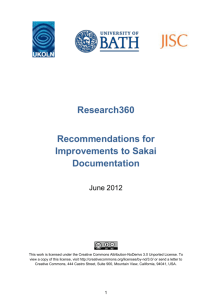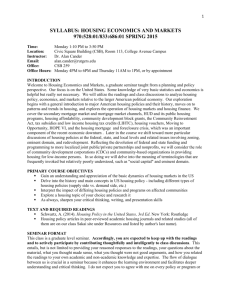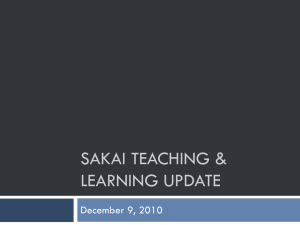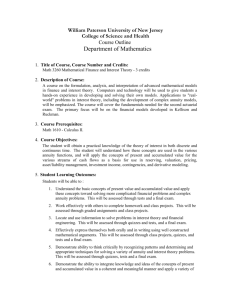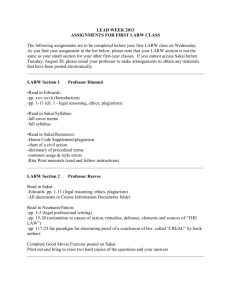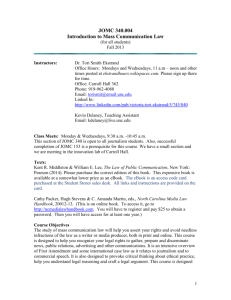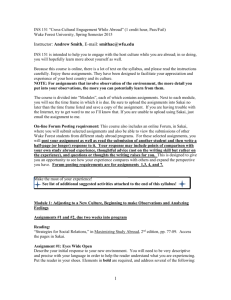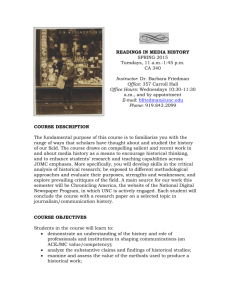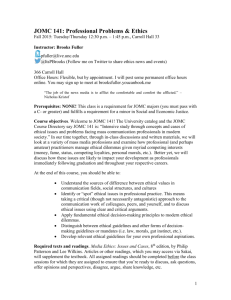Course Description
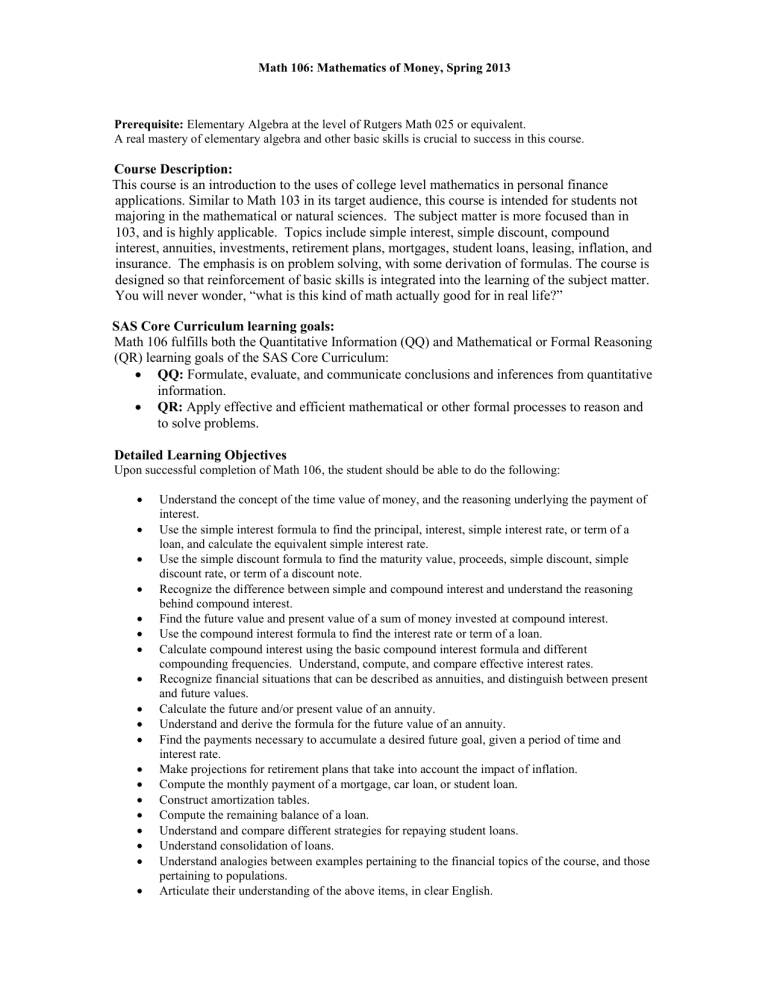
Math 106: Mathematics of Money, Spring 2013
Prerequisite: Elementary Algebra at the level of Rutgers Math 025 or equivalent.
A real mastery of elementary algebra and other basic skills is crucial to success in this course.
Course Description:
This course is an introduction to the uses of college level mathematics in personal finance applications. Similar to Math 103 in its target audience, this course is intended for students not majoring in the mathematical or natural sciences. The subject matter is more focused than in
103, and is highly applicable. Topics include simple interest, simple discount, compound interest, annuities, investments, retirement plans, mortgages, student loans, leasing, inflation, and insurance. The emphasis is on problem solving, with some derivation of formulas. The course is designed so that reinforcement of basic skills is integrated into the learning of the subject matter.
You will never wonder, “what is this kind of math actually good for in real life?”
SAS Core Curriculum learning goals:
Math 106 fulfills both the Quantitative Information (QQ) and Mathematical or Formal Reasoning
(QR) learning goals of the SAS Core Curriculum:
QQ: Formulate, evaluate, and communicate conclusions and inferences from quantitative information.
QR: Apply effective and efficient mathematical or other formal processes to reason and to solve problems.
Detailed Learning Objectives
Upon successful completion of Math 106, the student should be able to do the following:
Understand the concept of the time value of money, and the reasoning underlying the payment of interest.
Use the simple interest formula to find the principal, interest, simple interest rate, or term of a loan, and calculate the equivalent simple interest rate.
Use the simple discount formula to find the maturity value, proceeds, simple discount, simple discount rate, or term of a discount note.
Recognize the difference between simple and compound interest and understand the reasoning behind compound interest.
Find the future value and present value of a sum of money invested at compound interest.
Use the compound interest formula to find the interest rate or term of a loan.
Calculate compound interest using the basic compound interest formula and different compounding frequencies. Understand, compute, and compare effective interest rates.
Recognize financial situations that can be described as annuities, and distinguish between present and future values.
Calculate the future and/or present value of an annuity.
Understand and derive the formula for the future value of an annuity.
Find the payments necessary to accumulate a desired future goal, given a period of time and interest rate.
Make projections for retirement plans that take into account the impact of inflation.
Compute the monthly payment of a mortgage, car loan, or student loan.
Construct amortization tables.
Compute the remaining balance of a loan.
Understand and compare different strategies for repaying student loans.
Understand consolidation of loans.
Understand analogies between examples pertaining to the financial topics of the course, and those pertaining to populations.
Articulate their understanding of the above items, in clear English.
Textbook:
We have created a custom edition of The Mathematics of Money:Math for Business and Personal
Finance Decisions , by Timothy Biehler, McGraw-Hill 2008 (ISBN-13: 9781121262195). The full, non-custom edition (ISBN-13: 9781121119734) is perfectly acceptable as well, but is heavier, contains chapters we won’t use, and costs more. The custom edition is available at the campus bookstores in printed form. The full version is available as an e-book by going to https://create.mcgraw-hill.com/shop, entering the ISBN 9781121119734 (i.e. the full edition
ISBN, since that is what is available online), and following the steps from there.
Meeting times and places:
Instructor :
Email :
Office hours : TBA. In addition to traditional in-person office hours, there will also be a “virtual office hour” each week, at a time to be announced each week, held in the Sakai chat room.
Homework:
There will be frequent homework assignments. Due dates for each assignment will be indicated in class and on Sakai, and late homework will not be accepted. All written work must be submitted online via the Assignments area of Sakai, so be sure that you have an active email account and know your NetID and password. If you upload a file, it must be in one of the formats .doc, .docx, .pdf, or
.jpg
, and it is your responsibility to make certain that the file you upload is truly the one you intend, and appears as you intend it to when it is opened (legible, right side up, etc.). Moreover, unless specified otherwise, you must write your answers in complete, grammatically correct English sentences ; being able to do this is a crucial aspect of quantitative literacy, which goes beyond mere computational proficiency.
If you ever have technical difficulties with Sakai, especially in uploading homework, please contact the excellent and very responsive Sakai help desk at sakai@rutgers.edu
.
Doing the homework is crucial to learning the subject thoroughly, and the system of electronic submission makes it possible for you to get feedback quickly on whether you have done the homework correctly.
You are permitted, and in fact encouraged, to work together on homework problems, but all written work which you submit must ultimately be your own.
Quizzes:
Regular quizzes, announced in advance, will be given in class. There will be no makeup quizzes.
There will be no makeup quizzes. There will be no makeup quizzes. What is the policy on makeup quizzes? There will be none.
Exams:
There will be two midterm exams and one comprehensive final. The final is officially scheduled for [see scheduling.rutgers.edu/springfinals.shtml].
Missing an exam is a serious matter, and should only occur as a result of a genuine, verifiable emergency situation. "Verifiable" means that there should be a doctor's note, notice of court appearance, etc. indicating that you were unable to attend at the time of the exam. If circumstances beyond your control prevent you from attending an exam, it is important that you contact the instructor as quickly as possible.
Makeups: There are no makeup quizzes or exams. As noted above, under truly compelling circumstances an absence from a quiz or exam can be excused, but instead of having a makeup, the final exam will count correspondingly more heavily.
Course grade:
The overall course grade will be based on the following scheme:
Homework and quizzes
Exam #1
20 %
20 %
Exam #2
Final Exam
20 %
40 %
Calculators and spreadsheets:
Calculators will be used extensively in this course, in class, in homework, and on exams. Please bring one with you to each class meeting. For homework, you may find it very helpful to become comfortable using a spreadsheet program, such as Excel, which is available on all computers in the Rutgers computer labs. Computers and calculators with typewriter keyboards or built-in computer algebra systems (such as the TI-89 and TI-92) or with wifi capability (such as cellphones) will not be permitted on exams.
Online resources:
Sakai will be used extensively in this course. Access Sakai at sakai.rutgers.edu; login with your ordinary Rutgers NetID and password. Use Sakai to view announcements, submit homework via the Assignments feature, view solutions to homework problems via Resources, view your grades via the Gradebook, and participate in online discussions about the subject matter of the course in the Chat Room. If you ever have technical difficulties with Sakai, especially in uploading homework, please contact the excellent and very responsive Sakai help desk at sakai@rutgers.edu.
Attendance, and the classroom setting: You are expected to attend all class meetings, whose content will go far beyond a mere rehashing of the textbook. If you entertain the notion that you can succeed in the course by learning the material on your own, please think again.
Here is some good news about the classroom setting, and the value of the learning experience you will have there: the cell phone of the person next to you will not ring or vibrate during class, nor will he/she engage in the very distracting activity (to self and others) of sending or viewing text messages or surfing the internet during class, nor will he/she distract you by chatting. This is excellent news for you, and everyone else, since you have all paid a significant amount of money to be here, and there are ample opportunities for conversation and texting and updating your
Facebook page during the more than 150 hours per week when you are not in any of your classes.
Academic Integrity:
All students are expected to be familiar with and abide by the Rutgers policy on academic integrity; see http://academicintegrity.rutgers.edu/policy-on-academic-integrity. Violating this policy is a very serious matter, and you are strongly advised to observe it meticulously in all your courses.
Caution: The information in this syllabus is subject to change, as announced in class or via email/Sakai. No major changes are anticipated, but you are expected to attend class and check email regularly.
A few friendly words of advice: Never fall behind in a math course!!!!! The ideas we'll be discussing need time to sink in, and are very difficult to learn quickly right before an exam, so it is important to clear up your confusions sooner rather than later. An excellent way to improve your understanding of the subject is to study and work on homework together with classmates.
Explaining mathematical ideas to others is often the most effective way to sort out your own confusions and clarify your understanding; you don't know just what it is that you don't know until you try explaining it to someone else.
You are also warmly invited to ask questions in class, which students are far too hesitant to do in math courses, or in office hours, or by email, or in the Sakai Chat Room! I very much want you to succeed in this course.
Tentative class by class schedule (emphasis on “tentative”):
Topic Chapters
1.1, 1.2 Class 01: Simple interest, time value of money, term of a loan
Class 02:
Relationship among principal, interest rate, and time; gateway quiz
Class 03: Simple discount
Class 04: Simple discount contrast with simple interest
Class 05: Compound interest
Class 06: Compounding frequencies
Class 07: Effective interest rates
Class 08: Effective vs Nominal interest rates
Class 09: Solving for Time and Rate
Class 10: Solving for Time and Rate
Class 11: Catch up and review
1.3
2.1
2.2
3.1
3.2
3.3
3.4
3.5
3.5
Class 12: Midterm exam #1
Class 13: Definition and characteristics of annuities
Class 14: Future values of annuities; Derive formula for S n|i
Class 15: Future values of annuities; Applications of S n|i
4.1
4.2
4.2
4.3 Class 16: Sinking funds
Class 17: Present values of annuities
Class 18: Present value of annuities
Class 19: Amortization tables
4.4
4.4
4.5
4.5 Class 20: Refinancing and Consolidations
Class 21: Student loans
Class 22: Student loans
Class 23: Catch up and review
Class 24: Midterm exam #2
Class 25: Assessing effects of inflation
Class 26: Leasing
Class 27: Insurance
Class 28: Catch up and review
7.3
10.4

